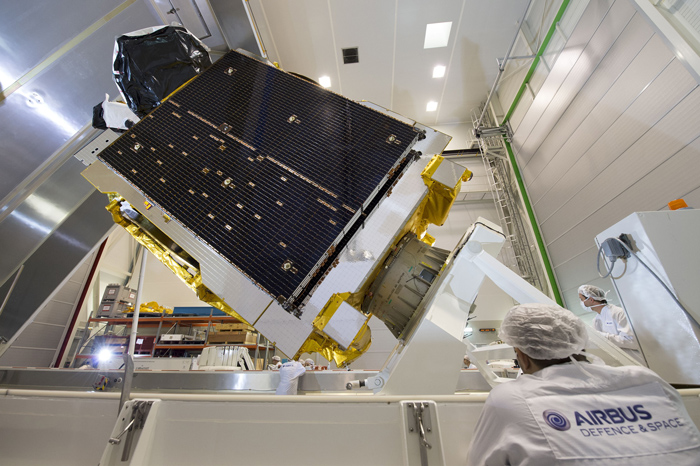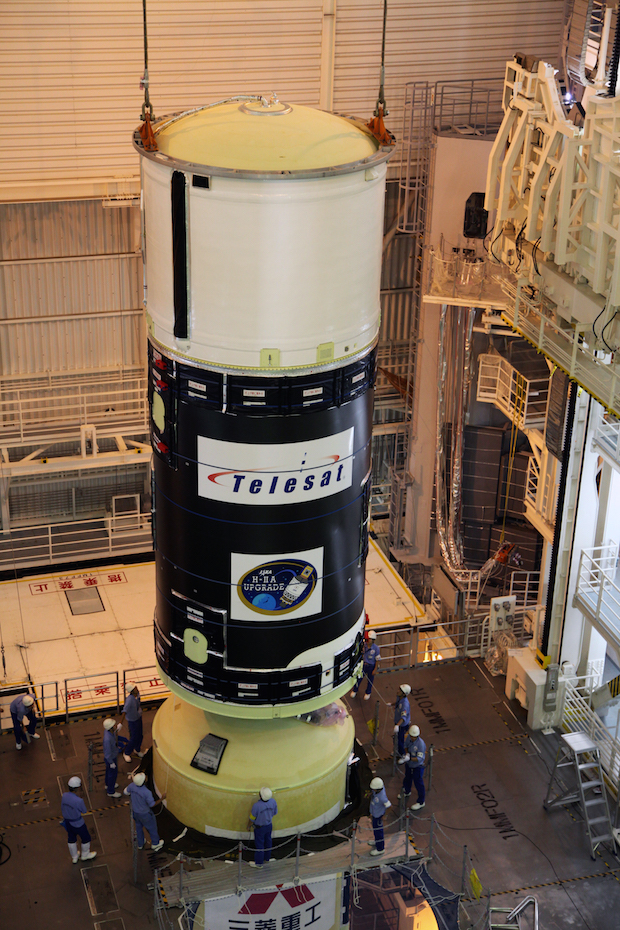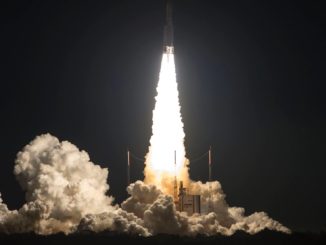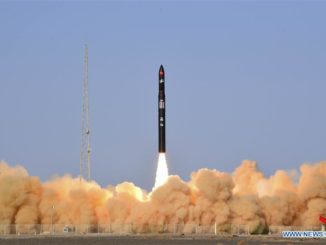
A Japanese H-2A rocket is set for liftoff Tuesday on its first fully commercial mission, carrying a communications satellite for Telesat of Canada that will bridge the Atlantic Ocean with expanded coverage for television broadcasters and mobile users from Latin America to the Middle East.
Engineers from Mitsubishi Heavy Industries, the H-2A rocket’s builder and operator, rolled the rocket out of its vehicle assembly building at the Tanegashima Space Center on Monday, transferring it to a nearby seafront launch complex for fueling and final preparations.
Launch crews will load cryogenic liquid hydrogen and liquid oxygen into the H-2A rocket in the hours before blastoff on its 29th flight.
Fitted with four solid rocket boosters, the H-2A is set for liftoff at 0623 GMT (1:23 a.m. EST) Tuesday, the opening of a 104-minute launch window.
The launch will debut an upgraded upper stage capable of a long-duration coast, extending the H-2A rocket’s in-orbit life span three hours over previous missions.
Japanese engineers updated the upper stage to allow the H-2A rocket to deploy communications satellites in higher orbits closer to their eventual operating posts in geostationary orbit, a belt 35,786 kilometers (22,236 miles) above the equator.
Satellites in geostationary orbit move around Earth at the same rate the planet rotates, making the spacecraft hover over a fixed geographic location, an ideal attribute for communications satellites.
Most rockets drop satellites heading for such high perches in egg-shaped transfer orbits with low points dipping well below geostationary altitude, leaving the spacecraft themselves to do the rest of the work. The energy required to push payloads toward orbits directly over the equator also counts against the satellites’ propellant reserves.
The result is satellites launched into lower orbits with higher inclinations — meaning farther from their final destinations — must consume more of their own fuel, reducing the amount left for the rest of their missions.
The payload on Tuesday’s launch is the Telstar 12 Vantage communications satellite, a multipurpose signals relay station owned by Telesat of Canada. Telesat selected the H-2A rocket for the launch in 2013, giving Japan’s workhorse launcher its first dedicated commercial flight.
The H-2A has flown commercial secondary payloads before, but the Telesat contract marked its first in the global telecom market.
Built by Airbus Defense and Space, Telstar 12 Vantage is heading for geostationary orbit at 15 degrees west longitude, but the upgrades slated to fly on Tuesday’s H-2A rocket launch will put Telstar 12 Vantage in a higher orbit than achievable on previous H-2A flights.

Many other rockets launching large communications satellites regularly place their payloads into higher orbits like the one targeted Tuesday, and Japanese officials said the H-2A needed the capability to become competitive in the global launch market.
Europe’s Ariane 5 rocket, which launches many commercial telecom satellites, flies from a space base in French Guiana near the equator, reducing the maneuvers the spacecraft must do for itself once in orbit.
Other rockets, such as Russia’s Proton/Breeze M, release their payloads in high-altitude orbits after up to nine hours of in-space maneuvers to overcome the high latitude of the Proton’s launch pad at the Baikonur Cosmodrome in Kazakhstan.
The H-2A rocket’s launch facility on Tanegashima Island, which lies just off the southern coast of the southernmost of Japan’s main islands, sits near 30 degrees north latitude, far enough from the equator to require payloads expend much of their own propellant to reach their intended geostationary orbits.
H-2A flights with communications satellites of Telstar 12 Vantage’s class before Tuesday carried payloads owned by the Japanese government, depositing the craft in stretched orbits at less than 300 kilometers (186 miles) on the low end and up to 35,786 kilometers (22,236 miles) at the high end.
At the conclusion of Tuesday’s launch, the Telstar 12 Vantage satellite will be in an orbit ranging from 2,700 kilometers (1,677 miles) to 35,586 kilometers (22,112 miles), with an inclination of 20.1 degrees.
The orbit leaves less lifting to be done with Telstar 12 Vantage’s on-board thrusters, leaving extra fuel in its tanks for a service life forecast to exceed 15 years.

“Through the upgrade development to improve its 2nd stage, the H-2A launch vehicle can allow a satellite in geostationary orbit to have a longer lifetime,” Mitsubishi Heavy Industries wrote in a document discussing the upgrades.
The higher orbit is possible due to a third firing of the H-2A rocket’s LE-5B upper stage engine, which only had to ignite twice on the launcher’s earlier missions.
Engineers have painted the upper stage’s liquid hydrogen tank white. The reflective paint will help keep the super-cold fuel from boiling off during the long coast between the second and third burns on Tuesday’s launch.
Designers added a lithium-ion battery to keep the rocket powered during the long flight, and propulsion engineers qualified the LE-5B engine for firings at a throttle setting of 60 percent, allowing for a more precise orbital injection, according to Mitsubishi Heavy Industries.
Other changes include a programmed roll to ensure components of the upper stage and the satellite do not get too hold or cold in the harsh vacuum of space, and the installation of tiny thrusters at the base of the upper stage to keep liquid hydrogen and liquid oxygen propellants near the bottom of their tanks, and eliminate the risk of sloshing.
Engineers also modified the LE-5B engine’s chill-down procedure, which conditions the powerplant for ignition. Cryogenic liquid oxygen will trickle through the engine turbopump during the coast to ensure it is ready for restart.
And there is a new payload separation system on Tuesday’s flight designed to give Telstar 12 Vantage a gentler nudge when it deploys from the H-2A rocket’s upper stage.
The first segment of Tuesday’s launch will be like most H-2A flights, with the rocket’s four strap-on boosters burning out and releasing in pairs two minutes into the flight. The rocket’s four-meter (13.1-foot) nose cone will jettison at T+plus 4 minutes, 10 seconds, followed by shutdown of the first stage’s LE-7A at T+plus 6 minutes, 40 seconds.
Staging should occur eight seconds later, then the upper stage LE-5B engine will fire up for the first of its three burns and switch off at T+plus 11 minutes, 7 seconds.
The second maneuver is scheduled to begin at T+plus 22 minutes, 36 seconds, and will end at T+plus 26 minutes, 37 seconds.
Then comes nearly four hours of quiet as the rocket climbs to geostationary altitude before restarting the LE-5B engine at T+plus 4 hours, 22 minutes, and 30 seconds. The third burn will last for one minute, according to a timeline provided by Mitsubishi.
Deployment of Telstar 12 Vantage is scheduled for T+plus 4 hours, 26 minutes, and 56 seconds.
Email the author.
Follow Stephen Clark on Twitter: @StephenClark1.



